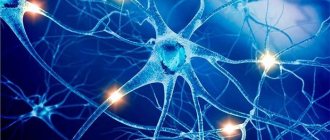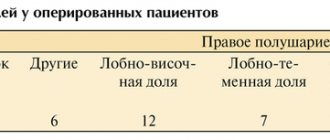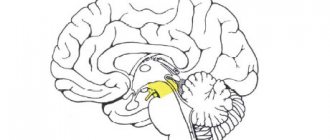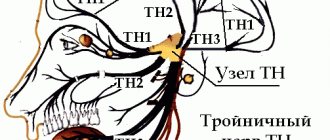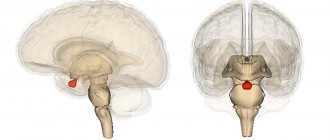Nervous system
(
lat.
systema nervosum), a morphofunctional set of individual neurons and other structures of the nervous tissue of animals and humans, uniting the activities of all organs and systems of the body in its constant interaction with the external environment. The nervous system perceives external and internal stimuli, analyzes and processes incoming information, stores traces of past activity (memory mechanisms) and accordingly regulates and coordinates body functions. The activity of the nervous system is based on a reflex associated with the spread of excitation along reflex arcs and the process of inhibition. The nervous system is composed primarily of nervous tissue, the basic structural and functional unit of which is the neuron.[1]
General development of the nervous system
Phylogeny of the nervous system
* in brief it boils down to the following. The simplest single-celled organisms (amoeba) do not yet have a nervous system, and communication with the environment is carried out using fluids located inside and outside the body - humoral (humor - liquid), a pre-nervous form of regulation.
* (Quote from the book: Sepp E.K. History of the development of the nervous system of vertebrates from skullless to humans. M., 1949.
)
Later, when the nervous system arises, another form of regulation appears - nervous. As the nervous system develops, nervous regulation increasingly subordinates humoral regulation, so that a single neuro-humoral regulation is formed with the leading role of the nervous system. The latter goes through a number of main stages in the process of phylogenesis (Fig. 265).
Rice. 265. Stages of development of the nervous system. 1 - diffuse nervous system; 2 - diffuse nervous system of hydra; 3 and 4 - nodal nervous system of the annelid worm
Stage I - reticular nervous system
. At this stage (coelenterates), the nervous system, such as hydra, consists of nerve cells, the numerous processes of which connect with each other in different directions, forming a network that diffusely permeates the entire body of the animal. When any point of the body is irritated, excitement spreads throughout the entire nervous network, and the animal reacts by moving its entire body. A reflection of this stage in humans is the network-like structure of the intramural nervous system.
Stage II - nodal nervous system
. At this stage (higher worms), nerve cells come together into separate clusters or groups, and from clusters of cell bodies, nerve nodes - centers are obtained, and from clusters of processes - nerve trunks - nerves. At the same time, in each cell the number of processes decreases, and they receive a certain direction. According to the segmental structure of the body of an animal, for example, an annelid, in each segment there are segmental nerve ganglia and nerve trunks. The latter connect nodes in two directions; transverse trunks connect nodes of a given segment, and longitudinal trunks connect nodes of different segments. Thanks to this, nerve impulses arising at any point in the body do not spread throughout the body, but spread along the transverse trunks within a given segment. Longitudinal trunks connect the nerve segments into one whole. At the head end of the animal, which, when moving forward, comes into contact with various objects of the surrounding world, sensory organs develop, and therefore the head nodes develop more strongly than others, being a prototype of the future brain. A reflection of this stage is the preservation of primitive features in humans (dispersion of nodes and microganglia on the periphery) in the structure of the autonomic nervous system.
Stage III - tubular nervous system
. At the initial stage of animal development, a particularly important role was played by the apparatus of movement, on the perfection of which depends the main condition for the existence of the animal - nutrition (movement in search of food, capturing and absorbing it).
In lower multicellular organisms, a peristaltic method of locomotion has developed, which is associated with smooth muscles and its local nervous apparatus. At a higher level, the peristaltic method is replaced by skeletal motility, i.e. movement using a system of rigid levers - over muscles (arthropods) and inside muscles (vertebrates). The consequence of this was the formation of striated muscles and a central nervous system that coordinates the movement of individual levers of the motor skeleton.
Such a central nervous system in chordates (lancelet) arose in the form of a metamerically constructed neural tube with segmental nerves extending from it to all segments of the body, including the movement apparatus - the trunk brain. In vertebrates and humans, the trunk cord becomes the spinal cord. Thus, the appearance of the trunk brain is associated with the improvement, first of all, of the animal’s motor weapons. Along with this, the lancelet also has receptors (olfactory, light). The further development of the nervous system and the emergence of the brain are mainly due to the improvement of receptor weapons.
Since most of the sense organs arise at that end of the animal’s body, which is facing the direction of movement, i.e. forward, then to perceive external stimuli coming through them, the anterior end of the trunk brain develops and the brain is formed, which coincides with the separation of the anterior end of the body into in the form of a head - cephalization (cephal - head).
E.K. Sepp in his manual on nervous diseases* gives a simplified but convenient for study diagram of the phylogeny of the brain, which we present here. According to this scheme, at the first stage of development, the brain consists of three sections: posterior, middle and anterior, and from these sections, the hind, or rhombencephalon, especially develops first (in lower fish). The development of the hindbrain occurs under the influence of acoustic and static receptors (receptors of the VIII pair of cephalic nerves), which are of key importance for orientation in the aquatic environment.
* (E. K. Sepp, M. B. Zucker, E. V. Schmidt, 1950.
)
In further evolution, the hindbrain differentiates into the medulla oblongata
, which is a transitional section from the spinal cord to the brain and is therefore called myelencephalon (myelos - spinal cord, encephalon - brain), and the
hindbrain itself
- metencephalon, from which the cerebellum and pons develop.
In the process of adapting the organism to the environment by changing metabolism, in the hindbrain, as the most developed part of the central nervous system at this stage, control centers for vital processes of plant life arise, associated, in particular, with the gill apparatus (breathing, blood circulation, digestion, etc. ). Therefore, the nuclei of the branchial nerves (group X pair - vagus) appear in the medulla oblongata. These vital centers of respiration and circulation remain in the human medulla oblongata, which explains the death that occurs when the medulla oblongata is damaged. At stage II (even in fish), the midbrain
, mesencephalon. At stage III, in connection with the final transition of animals from the aquatic environment to the air, the olfactory receptor intensively develops, perceiving chemical substances contained in the air, signaling with their smell about prey, danger and other vital phenomena of the surrounding nature.
Under the influence of the olfactory receptor, the forebrain—prosencephalon—develops, initially having the character of a purely olfactory brain. Subsequently, the forebrain grows and differentiates into the intermediate brain
- diencephalon and
final
- telencephalon.
In the telencephalon, as the highest part of the central nervous system, centers for all types of sensitivity appear. However, the underlying centers do not disappear, but remain, subordinate to the centers of the overlying floor. Consequently, with each new stage of brain development, new centers arise, subordinating the old ones. There seems to be a movement of functional centers to the head end and the simultaneous subordination of phylogenetically old rudiments to new ones. As a result, hearing centers that first arose in the hindbrain are also present in the middle and forebrain, vision centers that arose in the middle are also present in the forebrain, and olfactory centers are only in the forebrain. Under the influence of the olfactory receptor, a small part of the forebrain develops, therefore called the olfactory brain (rhinencephalon), which is covered with a gray matter cortex - the old cortex (paleocortex).
Improvement of receptors leads to the progressive development of the forebrain, which gradually becomes the organ that controls all animal behavior. There are two forms of animal behavior: instinctive, based on species reactions (unconditioned reflexes), and individual, based on the individual’s experience (conditioned reflexes). According to these two forms of behavior, two groups of gray matter centers develop in the telencephalon: subcortical nodes, which have the structure of nuclei (nuclear centers), and the gray matter cortex, which has the structure of a continuous screen (screen centers). In this case, the “subcortex” develops first, and then the cortex. The bark appears during the transition of an animal from an aquatic to a terrestrial lifestyle and is clearly found in amphibians and reptiles. The further evolution of the nervous system is characterized by the fact that the cerebral cortex increasingly subordinates the functions of all underlying centers to itself, and a gradual corticolization of functions
.
The necessary formation for the implementation of higher nervous activity is the new cortex, located on the surface of the hemispheres and acquiring a six-layer structure in the process of phylogenesis. Thanks to the enhanced development of the new cortex, the telencephalon in higher vertebrates surpasses all other parts of the brain, covering them like a cloak (pallium). The developing new brain (neencephalon) pushes into the depths the old brain (olfactory), which, as it were, curls up in the form of Ammon's horn (cornu Ammoni or pes hyppocampi), which still remains the olfactory center. The result is a cloak, i.e. a new brain
(neencephalon), sharply predominates over the rest of the brain - the old brain (paleencephalon).
So, the development of the brain takes place under the influence of the development of receptors, which explains that the highest part of the brain - the gray matter cortex - represents, as I. P. Pavlov teaches, a set of cortical ends of analyzers, i.e. a continuous perceiving (receptive) surface. Further development of the human brain is subject to other laws related to its social nature. In addition to the natural organs of the body, which are also found in animals, man began to use tools. Tools, which became artificial organs, complemented the natural organs of the body and constituted the technical equipment of man.
With the help of these weapons, man acquired the ability not only to adapt himself to nature, as animals do, but also to adapt nature to his needs. Labor, as mentioned above, was a decisive factor in the development of man, and in the process of social labor, a necessary means for people to communicate arose - speech. “First, work, and then, along with it, articulate speech, were the two most important stimuli, under the influence of which the monkey’s brain gradually turned into the human brain, which, for all its similarities with the monkey’s, far surpasses it in size and perfection” (K. Marx , F. Engels, Works, ed. 2, vol. 20, p. 490). This perfection is due to the maximum development of the telencephalon, especially its cortex - the new cortex (neocortex).
In addition to analyzers that perceive various stimuli from the external world and constitute the material substrate of concrete visual thinking characteristic of animals ( the first signal system
In reality, according to I.P. Pavlov), a person developed the ability of abstract, abstract thinking with the help of words, first heard (oral speech) and later visible (written speech).
This constituted the second signaling system
, according to I.P. Pavlov, which in the developing animal world was “an extraordinary addition to the mechanisms of nervous activity” (I.P. Pavlov). The material substrate of the second signal system was the surface layers of the neocortex. Therefore, the cerebral cortex reaches its highest development in humans. Thus, the entire evolution of the nervous system comes down to the progressive development of the telencephalon, which in higher vertebrates and especially in humans, due to the complication of nervous functions, reaches enormous sizes.
The stated patterns of phylogenesis determine the embryogenesis of the nervous system
person.
The nervous system originates from the outer germ layer, or ectoderm (see “Introduction”). This latter forms a longitudinal thickening called the medullary plate
(Fig. 266).
The medullary plate soon deepens into the medullary groove
, the edges of which (the medullary ridges) gradually become higher and then grow together, turning the groove into a tube (the
medullary tube
). The medullary tube is the rudiment of the central part of the nervous system. The posterior end of the tube forms the rudiment of the spinal cord, while its anterior extended end is divided by constrictions into three primary brain vesicles, from which the brain in all its complexity arises.
Rice. 266. Stages of embryogenesis of the nervous system in a cross-sectional schematic section. A - medullary plate; B and C - medullary groove; D and E - brain tube; 1 - horny leaf (epidermis); 2 - ganglion cushion
The medulla initially consists of only one layer of epithelial cells. During its closure into the brain tube, the number of cells in the walls of the latter increases, so that three layers appear: the inner one (facing the cavity of the tube), from which the epithelial lining of the brain cavities occurs (ependyma of the central canal of the spinal cord and ventricles of the brain); the middle one, from which the gray matter of the brain develops (nerve cells - neuroblasts), and finally, the outer one, almost free of cell nuclei, developing into the white matter (nerve cell processes - neurites). Bundles of neuroblast neurites spread either deep into the brain tube, forming the white matter of the brain, or extend into the mesoderm and then connect with young muscle cells (myoblasts). In this way motor nerves arise.
Sensory nerves arise from the rudiments of the spinal ganglia, which are visible already at the edges of the medullary groove at the place of its transition into the cutaneous ectoderm. When the groove closes into the brain tube, the rudiments are displaced to its dorsal side, located along the midline. Then the cells of these primordia move ventrally and are located again on the sides of the brain tube in the form of so-called ganglion ridges
. Both ganglionic ridges are laced clearly along the segments of the dorsal side of the embryo, as a result of which a number of spinal nodes, ganglia spinalia s, are obtained on each side. intervertebralia. In the head part of the brain tube they reach only the region of the posterior brain vesicle, where they form the rudiments of the nodes of the sensory head nerves. In the ganglion primordia, neuroblasts develop, taking the form of bipolar nerve cells, one of whose processes grows into the brain tube, the other goes to the periphery, forming a sensory nerve. Thanks to the fusion at some distance from the beginning of both processes, so-called false unipolar cells with one process dividing in the shape of the letter “T” are obtained from the bipolar ones, which are characteristic of the intervertebral nodes of an adult. The central processes of cells penetrating the spinal cord form the dorsal roots of the spinal nerves, and the peripheral processes, growing ventrally, form (together with the efferent fibers emerging from the spinal cord that make up the anterior root) a mixed spinal nerve. The rudiments of the autonomic nervous system also arise from the ganglion ridges.

